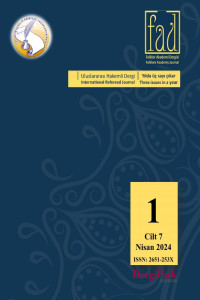Abstract
19.yüzyılın sonlarında ortaya çıkıp 20.yüzyılın başlarında etkisini keskin bir şekilde gösteren Modernizm, önceki tüm akımları etkisiz hale getirdi. Yeni bir bakış açısını edebiyata, kültüre, politikaya sunan bu akım, geçmişi reddetti ve özgün bir çerçevede yeniliği destekledi. Edebiyatta da yeniliğe kapı araladı. Hem içerik hem de şekil olarak edebi eserler farklı bir tarzda kaleme alındı. Eski geleneğin örnekleri olan basit, yüzeysel, tek tip eserler yerine; daha deneysel, doğrusal olmayan anlatılar, karakterlerin iç dünyasının incelendiği eserler ön plana çıktı. Bilinç akışı, metin içi parçalamalar, derin bir kötümserlik, okuyucuyu metne dahil etme gibi kavramlar, edebiyatın önemli ayrıntıları haline dönüştü. Yazarlar, bu özellikleri kullanarak hem yaşadıkları dönemi, hem de kendi ruhsal hayatlarını eserlere yansıtmaya çalıştılar. 20.yüzyılın başında ortaya çıkan ve tüm dünyayı derinden etkileyen Birinci Dünya Savaşı edebiyatı da şekillendirdi. Savaşa tanıklık eden yazarlar konularını savaştan almaya ve savaşın yıkıcı etkilerini anlatmaya başladılar. Bu yazarlardan birisi de modern edebiyatın öncülerinden Virginia Woolf'tur. Çalkantılı bir hayat geçiren Woolf'un yaşadığı psikolojik rahatsızlıklar, aynı zamanda dönemin getirdiği kaos, temalarının ve düşünce biçimlerinin üzerinde çok derin etkiler bırakmıştır. Kaleme aldığı günlükler, denemeler, romanlar dönemin izlerini taşır. Buna ek olarak, iç dünyasının karmaşıklığını da eserlerinde usta bir şekilde yansıtır. Bilinç akışı tekniği, karakterlerin iç dünyasının analizini ve parçalara ayırma tekniğini göz alıcı şekilde kullanan Woolf, olay örgüsünü bu şekilde sunar. 1927’de yazdığı To the Lighthouse (Deniz Feneri) eseri modern edebiyatın yapı taşlarından birisidir. Kitabı oluşturan üç bölüm vardır; bunlar The Window, Time Passes ve The Lighthouse’dur. Eserde dikkat çeken unsurlardan birisi karakterler arasındaki zıtlıklar, uyuşmazlıklar, anlaşmazlıklar ve parçalanmalardır. Virginia Woolf'un önemli bir yazım özelliği olan parçalama/parçalara ayırma(fragmentation) bu eserde de mevcuttur. Fakat Woolf'un olaylar ve karakterler arasındaki parçalanmayı ortadan kaldırdığını; parçalanmanın zıt karşılığı olan bir araya getirme/düzenlemeyi etkili bir şekilde yansıttığını söyleyebiliriz. Temel olarak, bu makalenin amacı, Woolf'un bahsi geçen eserinde parçaları bir araya getirmenin ve bütünlüğü sağlamanın örneklerini yansıtmaktır. Bunu yaparken başkarakterler, yan karakterler ve eserdeki önemli olaylar incelenmiş ve analiz edilmiştir.
References
- Bu bölüme kaynakça eklenmesi zorunludur.
Abstract
Modernism, which emerged in the late 19th century and took effect sharply in the early 20th century, paralyzed all previous movements. This movement, offering a new perspective on literature, culture, and politics, rejected the past and supported novelty in an original context. Additionaly, it opened the door to novelty in literature. Literary works were written in a different style, both in content and form. More experimental, non-linear narratives and works examining the inner world of the characters came to the fore instead of simple, superficial, standardized works which were examples of the old tradition. Concepts such as stream of consciousness, fragmentations, deep pessimism, and involving the reader in the text became important details of literature. By using these points, the authors tried to reflect both the period they lived in and their own spiritual lives in the works. The First World War, which broke out at the beginning of the 20th century and profoundly affected the whole world, shaped literature as well. Writers who witnessed the war began to take their subject matters from the war and describe the war’s devastating effects. One of these writers is Virginia Woolf, a pioneer of modern literature. The psychological disorders and a turbulent life experienced by Woolf as well as the chaos of the period had a deep impact on her themes and modes of thinking. The diaries, essays, and novels she wrote bear the traces of the period. In addition, she masterfully reflects the complexity of her inner world in the works. Using the stream of consciousness technique, the analysis of the characters' inner world, and the fragmentation magnificently, Woolf constructs the plot in this regard. Her work To the Lighthouse, written in 1927, is one of the cornerstones of modern literature. There are three parts that make up the book: The Window, Time Passes, and The Lighthouse. What stand out as striking elements in the work are the contrasts, inconsistencies, disagreements and fragmentations among the characters. Fragmentation, an important writing feature of Virginia Woolf, has an imortant place in the novel. But Woolf eliminates the fragmentation of the events and characters. It can be argued that she remarkably reflects integration, which is the opposite of fragmentation. Basically, the purpose of this article is to reflect on examples of integration of fragments and ensuring unity in Woolf's aforementioned work. While doing this, the main characters, side characters and significant events in the novel have been examined and analyzed.
References
- Bu bölüme kaynakça eklenmesi zorunludur.
Details
| Primary Language | English |
|---|---|
| Subjects | Literary Studies (Other) |
| Journal Section | Articles |
| Authors | |
| Early Pub Date | April 29, 2024 |
| Publication Date | April 30, 2024 |
| Submission Date | October 30, 2023 |
| Acceptance Date | January 24, 2024 |
| Published in Issue | Year 2024 Volume: 7 Issue: 1 |


